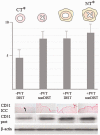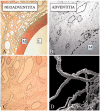Saphenous veins in coronary artery bypass grafting need external support
- PMID: 33307718
- PMCID: PMC8167919
- DOI: 10.1177/0218492320980936
Saphenous veins in coronary artery bypass grafting need external support
Abstract
The saphenous vein is the most commonly used conduit for coronary artery bypass grafting. Arterial grafts are harvested with the outer pedicle intact whereas saphenous veins are harvested with the pedicle removed in the conventional graft harvesting technique. This conventional procedure causes considerable vascular damage. One strategy to improve vein graft patency has been to provide external support. Ongoing studies show that fitting a metal external support improves conventionally harvested saphenous vein graft patency. On the other hand, the no-touch technique of harvesting the saphenous vein provides an improved graft with long-term patency comparable to that of the internal mammary artery. This improvement is suggested to be due to preservation of vessel structures. Interestingly, many of the mechanisms proposed to be associated with the beneficial actions of an artificial external support on saphenous vein graft patency are similar to those underlying the beneficial effect of no-touch saphenous vein grafts where the intact outer layer acts as a natural support. Additional actions of external supports have been advocated, including promotion of angiogenesis, increased production of vascular-protective factors, and protection of endothelial cells. Using no-touch harvesting, normal vascular architecture is maintained, tissue and cell damage is minimized, and factors beneficial for graft patency are preserved. In this review, the significance of external support of saphenous vein grafts in coronary artery bypass grafting is discussed.
Keywords: Coronary artery bypass; saphenous vein; stents; tissue and organ harvesting; vascular patency.
Conflict of interest statement
Figures





Similar articles
-
'No-touch' saphenous vein harvesting improves graft performance in patients undergoing coronary artery bypass surgery: a journey from bedside to bench.Vascul Pharmacol. 2013 Mar;58(3):240-50. doi: 10.1016/j.vph.2012.07.008. Epub 2012 Aug 8. Vascul Pharmacol. 2013. PMID: 22967905 Review.
-
An Obligatory Role of Perivascular Adipose Tissue in Improved Saphenous Vein Graft Patency in Coronary Artery Bypass Grafting.Circ J. 2024 May 24;88(6):845-852. doi: 10.1253/circj.CJ-23-0581. Epub 2023 Oct 31. Circ J. 2024. PMID: 37914280 Review.
-
The no-touch saphenous vein as the preferred second conduit for coronary artery bypass grafting.Ann Thorac Surg. 2013 Jul;96(1):105-11. doi: 10.1016/j.athoracsur.2013.01.102. Epub 2013 May 16. Ann Thorac Surg. 2013. PMID: 23684156 Clinical Trial.
-
What is the impact of preserving the endothelium on saphenous vein graft performance? Comments on the 'NO' touch harvesting technique.J Cardiothorac Surg. 2021 Mar 16;16(1):21. doi: 10.1186/s13019-021-01397-y. J Cardiothorac Surg. 2021. PMID: 33726786 Free PMC article.
-
Towards Endoscopic No-Touch Saphenous Vein Graft Harvesting in Coronary Bypass Surgery.Braz J Cardiovasc Surg. 2022 Sep 2;37(Spec 1):57-65. doi: 10.21470/1678-9741-2022-0144. Braz J Cardiovasc Surg. 2022. PMID: 36054003 Free PMC article. Review.
Cited by
-
Morphologic changes of the no-touch saphenous vein as Y-composite versus aortocoronary grafts (CONFIG Trial).PLoS One. 2025 May 8;20(5):e0322176. doi: 10.1371/journal.pone.0322176. eCollection 2025. PLoS One. 2025. PMID: 40338976 Free PMC article. Clinical Trial.
-
Comparing 3-month and 1-year patency rates of no-touch great saphenous vein and pedicled left internal mammary artery in off-pump coronary artery bypass grafting: a prospective non-inferiority study.Front Cardiovasc Med. 2025 Jun 16;12:1547482. doi: 10.3389/fcvm.2025.1547482. eCollection 2025. Front Cardiovasc Med. 2025. PMID: 40589452 Free PMC article.
-
The Short-Term Patency Rate of a Saphenous Vein Bridge Using the No-Touch Technique in off-Pump Coronary Artery Bypass Grafting in Vein Harvesting.Int J Gen Med. 2021 Jun 3;14:2281-2288. doi: 10.2147/IJGM.S311249. eCollection 2021. Int J Gen Med. 2021. PMID: 34113157 Free PMC article.
-
Advancing cardiac regeneration through 3D bioprinting: methods, applications, and future directions.Heart Fail Rev. 2024 May;29(3):599-613. doi: 10.1007/s10741-023-10367-6. Epub 2023 Nov 9. Heart Fail Rev. 2024. PMID: 37943420 Review.
-
Exosomes from umbilical cord-derived mesenchymal stem cells combined with gelatin methacryloyl inhibit vein graft restenosis by enhancing endothelial functions.J Nanobiotechnology. 2023 Oct 18;21(1):380. doi: 10.1186/s12951-023-02145-1. J Nanobiotechnology. 2023. PMID: 37848990 Free PMC article.
References
-
- Favaloro RG. Saphenous vein graft in the surgical treatment of coronary artery disease. Operative technique. J Thorac Cardiovasc Surg 1969; 58: 178–185. - PubMed
-
- Schwann TA, Habib RH, Wallace A, et al.. Operative outcomes of multiple-arterial versus single-arterial coronary bypass grafting. Ann Thorac Surg 2018; 105: 1109–1119. - PubMed
-
- Streeten DH. Orthostatic disorders of the circulation: mechanisms, manifestations, and treatment. Springer Science & Business Media, 2012.
-
- Ham A. Histology. 7th ed. Lippincott Williams & Wilkins, Philadelphia, 1974.
-
- Sabik JF, 3rd, Blackstone EH, Gillinov AM, Banbury MK, Smedira NG, Lytle BW. Influence of patient characteristics and arterial grafts on freedom from coronary reoperation. J Thorac Cardiovasc Surg 2006; 131: 90–98. - PubMed
Publication types
MeSH terms
LinkOut - more resources
Full Text Sources
Other Literature Sources

